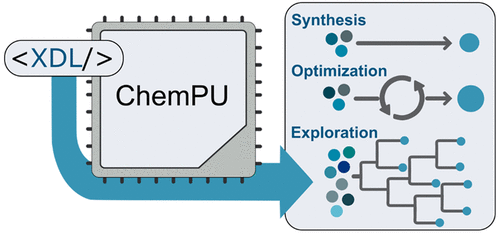当前位置:
X-MOL 学术
›
Acc. Chem. Res.
›
论文详情
Our official English website, www.x-mol.net, welcomes your
feedback! (Note: you will need to create a separate account there.)
Digitizing Chemistry Using the Chemical Processing Unit: From Synthesis to Discovery
Accounts of Chemical Research ( IF 16.4 ) Pub Date : 2020-12-28 , DOI: 10.1021/acs.accounts.0c00674 Liam Wilbraham 1 , S. Hessam M. Mehr 1 , Leroy Cronin 1
Accounts of Chemical Research ( IF 16.4 ) Pub Date : 2020-12-28 , DOI: 10.1021/acs.accounts.0c00674 Liam Wilbraham 1 , S. Hessam M. Mehr 1 , Leroy Cronin 1
Affiliation

|
The digitization of chemistry is not simply about using machine learning or artificial intelligence systems to process chemical data, or about the development of ever more capable automation hardware; instead, it is the creation of a hard link between an abstracted process ontology of chemistry and bespoke hardware for performing reactions or exploring reactivity. Chemical digitization is therefore about the unambiguous development of an architecture, a chemical state machine, that uses this ontology to connect precise instruction sets to hardware that performs chemical transformations. This approach enables a universal standard for describing chemistry procedures via a chemical programming language and facilitates unambiguous dissemination of these procedures. We predict that this standard will revolutionize the ability of chemists to collaborate, increase reproducibility and safety, as we all as optimize for cost and efficiency. Most importantly, the digitization of chemistry will dramatically reduce the labor needed to make new compounds and broaden accessible chemical space. In recent years, the developments of automation in chemistry have gone beyond flow chemistry alone, with many bespoke workflows being developed not only for automating chemical synthesis but also for materials, nanomaterials, and formulation production. Indeed, the leap from fixed-configuration synthesis machines like peptide, nucleic acid, or dedicated cross-coupling engines is important for developing a truly universal approach to “dial-a-molecule”. In this case, a key conceptual leap is the use of a batch system that can encode the chemical reagents, solvent, and products as packets which can be moved around the system, and a graph-based approach for the description of hardware modules that allows the compilation of chemical code that runs on, in principle, any hardware. Further, the integration of sensor systems for monitoring and controlling the state of the chemical synthesis machine, as well as high resolution spectroscopic tools, is vital if these systems are to facilitate closed-loop autonomous experiments. Systems that not only make molecules and materials, but also optimize their function, and use algorithms to assist with the development of new synthetic pathways and process optimization are also possible. Here, we discuss how the digitization of chemistry is happening, building on the plethora of technological developments in hardware and software. Importantly, digital-chemical robot systems need to integrate feedback from simple sensors, e.g., conductivity or temperature, as well as online analytics in order to navigate process space autonomously. This will open the door to accessing known molecules (synthesis), exploring whether known compounds/reactions are possible under new conditions (optimization), and searching chemical space for unknown and unexpected new molecules, reactions, and modes of reactivity (discovery). We will also discuss the role of chemical knowledge and how this can be used to challenge bias, as well as define and expand synthetically accessible chemical space using programmable robotic chemical state machines.
中文翻译:

使用化学处理单元对化学进行数字化:从合成到发现
化学数字化不仅仅涉及使用机器学习或人工智能系统来处理化学数据,还涉及开发功能越来越强大的自动化硬件。相反,它是在抽象的化学过程本体和用于执行反应或探索反应性的定制硬件之间创建硬链接。因此,化学数字化与架构的明确发展有关,即化学状态机,该架构使用此本体将精确的指令集连接到执行化学转换的硬件。这种方法使通过化学程序设计语言描述化学程序的通用标准成为可能,并且有助于这些程序的明确分发。我们预计,该标准将彻底改变化学家的协作能力,提高了可重复性和安全性,因为我们所有人都在优化成本和效率。最重要的是,化学数字化将大大减少制造新化合物和拓宽可利用化学空间所需的劳动力。近年来,化学自动化领域的发展已不仅仅是流体化学领域,不仅为自动化化学合成,还为材料,纳米材料和配方生产开发了许多定制的工作流程。实际上,从固定构型的合成机器(如肽,核酸或专用的交叉耦合引擎)的飞跃对于开发一种真正通用的“拨号分子”方法非常重要。在这种情况下,关键的概念性飞跃是使用可以对化学试剂,溶剂,产品和产品(可以在系统中移动的数据包),以及基于图形的方法来描述硬件模块,该方法允许编译原则上可在任何硬件上运行的化学代码。此外,如果要监视和控制化学合成机的状态以及高分辨率光谱仪工具的传感器系统要促进闭环自主实验,则至关重要。不仅可以制造分子和材料,还可以优化其功能,并使用算法来协助开发新的合成途径和工艺优化的系统也是可能的。在此,我们基于大量的软硬件技术发展来讨论化学数字化是如何发生的。重要的,数字化学机器人系统需要集成来自简单传感器(例如电导率或温度)的反馈以及在线分析,以便自主导航过程空间。这将为获取已知分子(合成),探索已知化合物/反应在新条件下(优化)是否可能以及为未知和意外的新分子,反应和反应方式(发现)寻找化学空间打开大门。我们还将讨论化学知识的作用以及如何将其用于挑战偏见,以及使用可编程机器人化学状态机定义和扩展可合成访问的化学空间。这将为获取已知分子(合成),探索已知化合物/反应在新条件下(优化)是否可能以及为未知和意外的新分子,反应和反应方式(发现)寻找化学空间打开大门。我们还将讨论化学知识的作用以及如何将其用于挑战偏见,以及使用可编程机器人化学状态机定义和扩展可合成访问的化学空间。这将为获取已知分子(合成),探索已知化合物/反应在新条件下(优化)是否可能以及为未知和意外的新分子,反应和反应方式(发现)寻找化学空间打开大门。我们还将讨论化学知识的作用以及如何将其用于挑战偏见,以及使用可编程机器人化学状态机定义和扩展可合成访问的化学空间。
更新日期:2021-01-19
中文翻译:

使用化学处理单元对化学进行数字化:从合成到发现
化学数字化不仅仅涉及使用机器学习或人工智能系统来处理化学数据,还涉及开发功能越来越强大的自动化硬件。相反,它是在抽象的化学过程本体和用于执行反应或探索反应性的定制硬件之间创建硬链接。因此,化学数字化与架构的明确发展有关,即化学状态机,该架构使用此本体将精确的指令集连接到执行化学转换的硬件。这种方法使通过化学程序设计语言描述化学程序的通用标准成为可能,并且有助于这些程序的明确分发。我们预计,该标准将彻底改变化学家的协作能力,提高了可重复性和安全性,因为我们所有人都在优化成本和效率。最重要的是,化学数字化将大大减少制造新化合物和拓宽可利用化学空间所需的劳动力。近年来,化学自动化领域的发展已不仅仅是流体化学领域,不仅为自动化化学合成,还为材料,纳米材料和配方生产开发了许多定制的工作流程。实际上,从固定构型的合成机器(如肽,核酸或专用的交叉耦合引擎)的飞跃对于开发一种真正通用的“拨号分子”方法非常重要。在这种情况下,关键的概念性飞跃是使用可以对化学试剂,溶剂,产品和产品(可以在系统中移动的数据包),以及基于图形的方法来描述硬件模块,该方法允许编译原则上可在任何硬件上运行的化学代码。此外,如果要监视和控制化学合成机的状态以及高分辨率光谱仪工具的传感器系统要促进闭环自主实验,则至关重要。不仅可以制造分子和材料,还可以优化其功能,并使用算法来协助开发新的合成途径和工艺优化的系统也是可能的。在此,我们基于大量的软硬件技术发展来讨论化学数字化是如何发生的。重要的,数字化学机器人系统需要集成来自简单传感器(例如电导率或温度)的反馈以及在线分析,以便自主导航过程空间。这将为获取已知分子(合成),探索已知化合物/反应在新条件下(优化)是否可能以及为未知和意外的新分子,反应和反应方式(发现)寻找化学空间打开大门。我们还将讨论化学知识的作用以及如何将其用于挑战偏见,以及使用可编程机器人化学状态机定义和扩展可合成访问的化学空间。这将为获取已知分子(合成),探索已知化合物/反应在新条件下(优化)是否可能以及为未知和意外的新分子,反应和反应方式(发现)寻找化学空间打开大门。我们还将讨论化学知识的作用以及如何将其用于挑战偏见,以及使用可编程机器人化学状态机定义和扩展可合成访问的化学空间。这将为获取已知分子(合成),探索已知化合物/反应在新条件下(优化)是否可能以及为未知和意外的新分子,反应和反应方式(发现)寻找化学空间打开大门。我们还将讨论化学知识的作用以及如何将其用于挑战偏见,以及使用可编程机器人化学状态机定义和扩展可合成访问的化学空间。











































 京公网安备 11010802027423号
京公网安备 11010802027423号